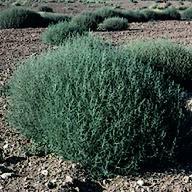

Common Name: Russian
Thistle
Genus: Salsola
Species: collina

When westerns were big in the movies, you could always hear some lonesome cowboy sing about the tumbling tumbleweed. The tumbleweed stood for everything a cowboy was; a little ugly, lanky, and a foot loose rambler. Deserted ghost towns would have tumbleweeds rolling down main street.
Would you believe that tumbleweed actually hitched a ride from the steppes of Mongolia with a shipment of grain? That's how it got here, and it isn't a native plant at all. Very strange, but true.
Tumbleweed is also known as Russian thistle, and is a member of the Goosefoot family. It is a round, bushy, much-branched plant growing 1 to 3-1/2 feet high. The branches are slender, and soft when young, woody when mature. The leaves are alternate. The first ones start off being dark green, soft, slender, and 1 to 2-1/2 inches long. These drop off and the next set of leaves are short, stiff, spiny, and not over 1/2 inch long. The flowers are small, green-white or pink in color. Seeds are about 1/16 inch in diameter and shaped like a cone.
Tumbleweed grows on dry plains, in cultivated fields, roadsides, and waste places, mainly in grain-growing areas. It has a special way of broadcasting its seeds. It doesn't depend on the wind, or birds. It doesn't hitchhike on the fur of animals. When it becomes mature, it breaks off at the base and because it is shaped like a ball, it tumbles before the wind, scattering seeds where ever it goes. It is all over Colorado up to 8,500 feet.
2000
Bibliography:
"Russian Thistle", http://www.cwma.org/russian_thistle.html, (Sept. 2000).
"Weed Guide: Rusian Thisle", http://www.agf.gov.bc.ca/croplive/cropprot/weedguid/russthis.htm, (Sept. 2000).